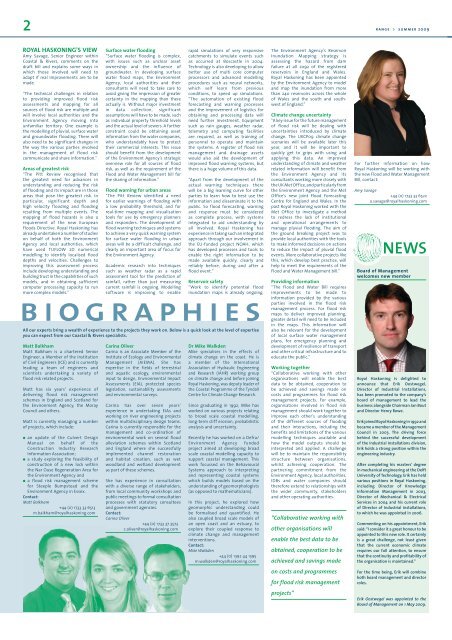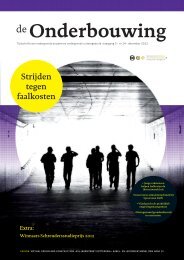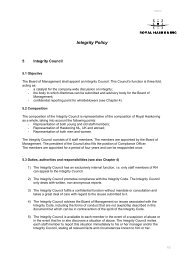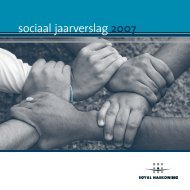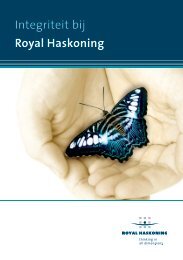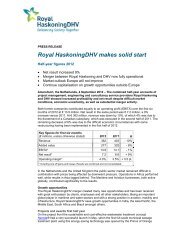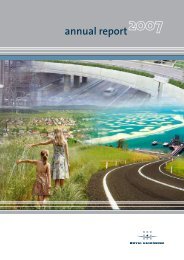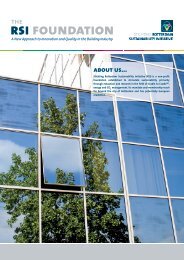Summer 2009 - Royal Haskoning
Summer 2009 - Royal Haskoning
Summer 2009 - Royal Haskoning
Create successful ePaper yourself
Turn your PDF publications into a flip-book with our unique Google optimized e-Paper software.
2<br />
ROYAL HASKONING’S VIEW<br />
Amy Savage, Senior Engineer within<br />
Coastal & Rivers, comments on the<br />
draft bill and explains some ways in<br />
which those involved will need to<br />
adapt if real improvements are to be<br />
made.<br />
“The technical challenges in relation<br />
to providing improved flood risk<br />
assessments and mapping for all<br />
sources of flood risk are multiple and<br />
will involve local authorities and the<br />
Environment Agency moving into<br />
unfamiliar territory. One example is<br />
the modelling of pluvial, surface water<br />
and groundwater flooding. There will<br />
also need to be significant changes in<br />
the way the various parties involved<br />
in the management of flood risk<br />
communicate and share information.”<br />
Areas of greatest risk<br />
“The Pitt Review recognised that<br />
the greatest need for advances in<br />
understanding and reducing the risk<br />
of flooding and its impact are in those<br />
areas that pose the greatest risk. In<br />
particular, significant depth and<br />
high velocity flooding and flooding<br />
resulting from multiple events. The<br />
mapping of flood hazards is also a<br />
requirement of the new European<br />
Floods Directive. <strong>Royal</strong> <strong>Haskoning</strong> has<br />
already undertaken a number of studies<br />
on behalf of both the Environment<br />
Agency and local authorities, which<br />
have used TUFLOW 2D numerical<br />
modelling to identify localised flood<br />
depths and velocities. Challenges to<br />
improving this assessment process<br />
include developing understanding and<br />
building trust in the capabilities of such<br />
models, and in obtaining sufficient<br />
computer processing capacity to run<br />
more complex models.”<br />
Surface water flooding<br />
“Surface water flooding is complex,<br />
with issues such as unclear asset<br />
ownership and the influence of<br />
groundwater. In developing surface<br />
water flood maps, the Environment<br />
Agency, local authorities and their<br />
consultants will need to take care to<br />
avoid giving the impression of greater<br />
certainty in the mapping than there<br />
actually is. Without major investment<br />
in data collection, significant<br />
assumptions will have to be made, such<br />
as individual property threshold levels<br />
and the actual level of sewers. A further<br />
constraint could be obtaining asset<br />
information from the water companies,<br />
who understandably have to protect<br />
their commercial interests. This issue<br />
should benefit from the development<br />
of the Environment Agency’s strategic<br />
overview role for all sources of flood<br />
risk, as well as the requirement of the<br />
Flood and Water Management bill for<br />
the sharing of information.”<br />
Flood warning for urban areas<br />
“The Pitt Review identified a need<br />
for earlier warnings of flooding with<br />
a low probability threshold, and for<br />
real-time mapping and visualisation<br />
tools for use by emergency planners<br />
and responders. The development of<br />
flood warning techniques and systems<br />
to achieve a very quick warning system<br />
for surface water flooding in urban<br />
areas will be a difficult challenge, and<br />
clearly an important area of focus for<br />
the Environment Agency.<br />
Academic research into techniques<br />
such as weather radar as a rapid<br />
assessment tool for the prediction of<br />
rainfall, rather than just measuring<br />
current rainfall is ongoing. Modelling<br />
software is improving to enable<br />
rapid simulations of very responsive<br />
catchments to simulate events such<br />
as occurred at Boscastle in 2004.<br />
Technology is also developing to allow<br />
better use of multi core computer<br />
processors and advanced modelling<br />
procedures such as neural networks,<br />
which self learn from previous<br />
conditions, to speed up simulations.<br />
“The automation of existing flood<br />
forecasting and warning processes<br />
and the improvement of logistics for<br />
obtaining and processing data will<br />
need further investment. Equipment<br />
such as rain gauges, weather radar,<br />
telemetry and computing facilities<br />
are required, as well as training of<br />
personnel to operate and maintain<br />
the systems. A register of flood risk<br />
management and drainage assets<br />
would also aid the development of<br />
improved flood warning systems, but<br />
there is a huge volume of this data.<br />
“Apart from the development of the<br />
actual warning techniques there<br />
will be a big learning curve for other<br />
parties to learn how to best use the<br />
information and disseminate it to the<br />
public. So flood forecasting, warning<br />
and response must be considered<br />
as complete process, with systems<br />
integrated to aid understanding by<br />
all involved. <strong>Royal</strong> <strong>Haskoning</strong> has<br />
experience in taking such an integrated<br />
approach through our involvement in<br />
the EU-funded project NOAH, which<br />
has developed processes and tools to<br />
enable the right information to be<br />
made available quickly, clearly and<br />
reliably before, during and after a<br />
flood event.”<br />
Reservoir safety<br />
“Work to identify potential flood<br />
inundation maps is already ongoing.<br />
b i o g r a p h i e s<br />
All our experts bring a wealth of experience to the projects they work on. Below is a quick look at the level of expertise<br />
you can expect from our Coastal & Rivers specialists.<br />
Matt Balkham<br />
Matt Balkham is a chartered Senior<br />
Engineer, a Member of the Institution<br />
of Civil Engineers (ICE) and is currently<br />
leading a team of engineers and<br />
scientists undertaking a variety of<br />
flood risk related projects.<br />
Matt has six years’ experience of<br />
delivering flood risk management<br />
schemes in England and Scotland for<br />
the Environment Agency, the Moray<br />
Council and others.<br />
Matt is currently managing a number<br />
of projects, which include:<br />
l an update of the Culvert Design<br />
Manual on behalf of the<br />
Construction Industry Research<br />
Information Association;<br />
l a study exploring the feasibility of<br />
construction of a new lock within<br />
the Nar Ouse Regeneration Area for<br />
the Environment Agency and<br />
l a flood risk management scheme<br />
for Steeple Bumpstead and the<br />
Environment Agency in Essex.<br />
Contact:<br />
Matt Balkham<br />
+44 (0) 1733 33 6513<br />
m.balkham@royalhaskoning.com<br />
Carina Oliver<br />
Carina is an Associate Member of the<br />
Institute of Ecology and Environmental<br />
Management (AIEMA). She has<br />
expertise in the fields of terrestrial<br />
and aquatic ecology, environmental<br />
input to design, Environmental Impact<br />
Assessments (EIA), protected species<br />
legislation, sustainability assessments<br />
and environmental surveys.<br />
Carina has over seven years’<br />
experience in undertaking EIAs and<br />
working on river engineering projects<br />
within multidisciplinary design teams.<br />
Carina is currently responsible for the<br />
management and co-ordination of<br />
environmental work on several flood<br />
alleviation schemes within Scotland<br />
and England where she successfully<br />
implemented channel restoration<br />
and habitat creation, such as wet<br />
woodland and wetland development<br />
as part of these schemes.<br />
She has experience in consultation<br />
with a diverse range of stakeholders,<br />
from local community workshops and<br />
public meetings to formal consultation<br />
processes with statutory consultees<br />
and government agencies.<br />
Contact:<br />
Carina Oliver<br />
+44 (0) 1733 37 3573<br />
c.oliver@royalhaskoning.com<br />
Dr Mike Walkden<br />
Mike specialises in the effects of<br />
climate change on the coast. He is<br />
a member of the International<br />
Association of Hydraulic Engineering<br />
and Research (IAHR) working group<br />
on climate change and before joining<br />
<strong>Royal</strong> <strong>Haskoning</strong>, was deputy leader of<br />
the Coastal Programme of the Tyndall<br />
Centre for Climate Change Research.<br />
Since graduating in 1992, Mike has<br />
worked on various projects relating<br />
to broad scale coastal modelling,<br />
long-term cliff erosion, probabilistic<br />
analysis and uncertainty.<br />
Recently he has worked on a Defra/<br />
Environment Agency funded<br />
project aimed at developing broad<br />
scale coastal modelling capacity to<br />
support coastal management. This<br />
work focussed on the Behavioural<br />
Systems approach to interpreting<br />
and representing coastal systems<br />
which builds models based on the<br />
understanding of geomorphologists<br />
(as opposed to mathematicians).<br />
In this project, he explored how<br />
geomorphic understanding could<br />
be formalised and quantified. He<br />
also coupled broad scale models of<br />
an open coast and an estuary, to<br />
explore their coupled response to<br />
climate change and management<br />
interventions.<br />
Contact:<br />
Mike Walkden<br />
+44 (0) 1392 44 1395<br />
m.walkden@royalhaskoning.com<br />
The Environment Agency’s Reservoir<br />
Inundation Mapping strategy is<br />
assessing the hazard from dam<br />
failure at all 2092 of the registered<br />
reservoirs in England and Wales.<br />
<strong>Royal</strong> <strong>Haskoning</strong> has been appointed<br />
by the Environment Agency to model<br />
and map the inundation from more<br />
than 240 reservoirs across the whole<br />
of Wales and the south and southwest<br />
of England.”<br />
Climate change uncertainty<br />
“A key issue for the future management<br />
of flood risk will be dealing with<br />
uncertainties introduced by climate<br />
change. The UKCP09 climate change<br />
scenarios will be available later this<br />
year, and it will be important to<br />
quickly get to grips with using and<br />
applying this data. An improved<br />
understanding of climate and weather<br />
related information will benefit from<br />
the Environment Agency and its<br />
consultants working more closely with<br />
the UK Met Office, and particularly from<br />
the Environment Agency and the Met<br />
Office’s new joint Flood Forecasting<br />
Centre for England and Wales. In the<br />
past <strong>Royal</strong> <strong>Haskoning</strong> worked with the<br />
Met Office to investigate a method<br />
to redress the lack of institutional<br />
and operational arrangements to<br />
manage pluvial flooding. The aim of<br />
the ground breaking project was to<br />
provide local authorities with the tools<br />
to make informed decisions on actions<br />
to reduce the impact of pluvial flood<br />
events. More collaborative projects like<br />
this, which develop best practice, will<br />
help to meet the requirements of the<br />
Flood and Water Management bill.”<br />
Providing information<br />
“The Flood and Water Bill requires<br />
improvements to be made to<br />
information provided by the various<br />
parties involved in the flood risk<br />
management process. For flood risk<br />
maps to deliver improved planning,<br />
greater detail will need to be included<br />
in the maps. This information will<br />
also be relevant for the development<br />
of local surface water management<br />
plans, for emergency planning and<br />
development of resilience of transport<br />
and other critical infrastructure and to<br />
educate the public.”<br />
Working together<br />
“Collaborative working with other<br />
organisations will enable the best<br />
data to be obtained, cooperation to<br />
be achieved and savings made on<br />
costs and programmes for flood risk<br />
management projects. For example,<br />
organisations involved in flood risk<br />
management should work together to<br />
improve each other’s understanding<br />
of the different sources of flooding<br />
and their interactions, including the<br />
benefits and limitations of the various<br />
modelling techniques available and<br />
how the model outputs should be<br />
interpreted and applied. A challenge<br />
will be to maintain the responsibility<br />
structure between organisations,<br />
whilst achieving cooperation. The<br />
partnering commitment from the<br />
Environment Agency, local authorities,<br />
IDBs and water companies should<br />
therefore extend to relationships with<br />
the wider community, stakeholders<br />
and other operating authorities.<br />
“Collaborative working with<br />
other organisations will<br />
enable the best data to be<br />
obtained, cooperation to be<br />
achieved and savings made<br />
on costs and programmes<br />
for flood risk management<br />
projects”<br />
range > summer <strong>2009</strong><br />
For further information on how<br />
<strong>Royal</strong> <strong>Haskoning</strong> will be working with<br />
the new Flood and Water Management<br />
Bill, contact:<br />
Amy Savage<br />
+44 (0) 1733 33 6522<br />
a.savage@royalhaskoning.com<br />
NEWS<br />
Board of Management<br />
welcomes new member<br />
<strong>Royal</strong> <strong>Haskoning</strong> is delighted to<br />
announce that Erik Oostwegel,<br />
Director of Industrial Installations,<br />
has been promoted to the company’s<br />
board of management to lead the<br />
business alongside Chairman Jan Bout<br />
and Director Henry Rowe.<br />
Erik joined <strong>Royal</strong> <strong>Haskoning</strong> in 1992 and<br />
became a member of the Management<br />
Council in 2003. The driving force<br />
behind the successful development<br />
of the Industrial Installations division,<br />
Erik holds a strong position within the<br />
engineering industry.<br />
After completing his masters’ degree<br />
in mechanical engineering at the Delft<br />
University of Technology, Erik has held<br />
various positions in <strong>Royal</strong> <strong>Haskoning</strong>,<br />
including Director of Knowledge<br />
Information Management in 2003,<br />
Director of Mechanical & Electrical<br />
Services in 2004 and his current role<br />
of Director of Industrial installations,<br />
to which he was appointed in 2006.<br />
Commenting on his appointment, Erik<br />
said: “I consider it a great honour to be<br />
appointed to this new role. It certainly<br />
is a great challenge, not least given<br />
that the current economic climate<br />
requires our full attention, to ensure<br />
that the continuity and profitability of<br />
the organisation is maintained.”<br />
For the time being, Erik will combine<br />
both board management and director<br />
roles.<br />
Erik Oostwegel was appointed to the<br />
Board of Management on 1 May <strong>2009</strong>.


